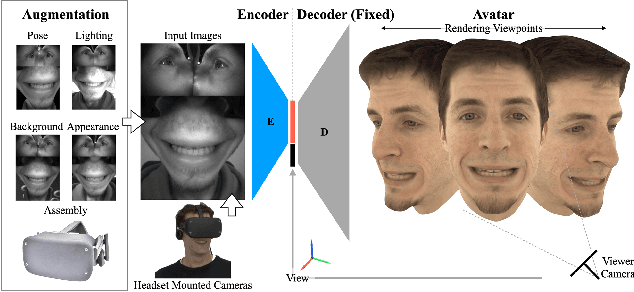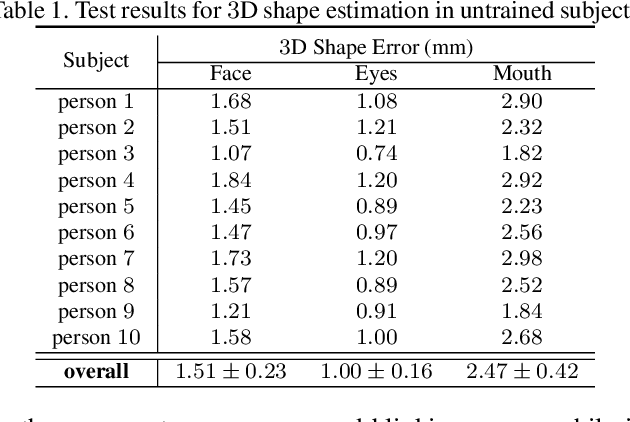Te-Li Wang
REWIND: Real-Time Egocentric Whole-Body Motion Diffusion with Exemplar-Based Identity Conditioning
Apr 08, 2025Abstract:We present REWIND (Real-Time Egocentric Whole-Body Motion Diffusion), a one-step diffusion model for real-time, high-fidelity human motion estimation from egocentric image inputs. While an existing method for egocentric whole-body (i.e., body and hands) motion estimation is non-real-time and acausal due to diffusion-based iterative motion refinement to capture correlations between body and hand poses, REWIND operates in a fully causal and real-time manner. To enable real-time inference, we introduce (1) cascaded body-hand denoising diffusion, which effectively models the correlation between egocentric body and hand motions in a fast, feed-forward manner, and (2) diffusion distillation, which enables high-quality motion estimation with a single denoising step. Our denoising diffusion model is based on a modified Transformer architecture, designed to causally model output motions while enhancing generalizability to unseen motion lengths. Additionally, REWIND optionally supports identity-conditioned motion estimation when identity prior is available. To this end, we propose a novel identity conditioning method based on a small set of pose exemplars of the target identity, which further enhances motion estimation quality. Through extensive experiments, we demonstrate that REWIND significantly outperforms the existing baselines both with and without exemplar-based identity conditioning.
Universal Facial Encoding of Codec Avatars from VR Headsets
Jul 17, 2024



Abstract:Faithful real-time facial animation is essential for avatar-mediated telepresence in Virtual Reality (VR). To emulate authentic communication, avatar animation needs to be efficient and accurate: able to capture both extreme and subtle expressions within a few milliseconds to sustain the rhythm of natural conversations. The oblique and incomplete views of the face, variability in the donning of headsets, and illumination variation due to the environment are some of the unique challenges in generalization to unseen faces. In this paper, we present a method that can animate a photorealistic avatar in realtime from head-mounted cameras (HMCs) on a consumer VR headset. We present a self-supervised learning approach, based on a cross-view reconstruction objective, that enables generalization to unseen users. We present a lightweight expression calibration mechanism that increases accuracy with minimal additional cost to run-time efficiency. We present an improved parameterization for precise ground-truth generation that provides robustness to environmental variation. The resulting system produces accurate facial animation for unseen users wearing VR headsets in realtime. We compare our approach to prior face-encoding methods demonstrating significant improvements in both quantitative metrics and qualitative results.
* SIGGRAPH 2024 (ACM Transactions on Graphics (TOG))
Fast Registration of Photorealistic Avatars for VR Facial Animation
Jan 19, 2024



Abstract:Virtual Reality (VR) bares promise of social interactions that can feel more immersive than other media. Key to this is the ability to accurately animate a photorealistic avatar of one's likeness while wearing a VR headset. Although high quality registration of person-specific avatars to headset-mounted camera (HMC) images is possible in an offline setting, the performance of generic realtime models are significantly degraded. Online registration is also challenging due to oblique camera views and differences in modality. In this work, we first show that the domain gap between the avatar and headset-camera images is one of the primary sources of difficulty, where a transformer-based architecture achieves high accuracy on domain-consistent data, but degrades when the domain-gap is re-introduced. Building on this finding, we develop a system design that decouples the problem into two parts: 1) an iterative refinement module that takes in-domain inputs, and 2) a generic avatar-guided image-to-image style transfer module that is conditioned on current estimation of expression and head pose. These two modules reinforce each other, as image style transfer becomes easier when close-to-ground-truth examples are shown, and better domain-gap removal helps registration. Our system produces high-quality results efficiently, obviating the need for costly offline registration to generate personalized labels. We validate the accuracy and efficiency of our approach through extensive experiments on a commodity headset, demonstrating significant improvements over direct regression methods as well as offline registration.
Robust Egocentric Photo-realistic Facial Expression Transfer for Virtual Reality
Apr 10, 2021



Abstract:Social presence, the feeling of being there with a real person, will fuel the next generation of communication systems driven by digital humans in virtual reality (VR). The best 3D video-realistic VR avatars that minimize the uncanny effect rely on person-specific (PS) models. However, these PS models are time-consuming to build and are typically trained with limited data variability, which results in poor generalization and robustness. Major sources of variability that affects the accuracy of facial expression transfer algorithms include using different VR headsets (e.g., camera configuration, slop of the headset), facial appearance changes over time (e.g., beard, make-up), and environmental factors (e.g., lighting, backgrounds). This is a major drawback for the scalability of these models in VR. This paper makes progress in overcoming these limitations by proposing an end-to-end multi-identity architecture (MIA) trained with specialized augmentation strategies. MIA drives the shape component of the avatar from three cameras in the VR headset (two eyes, one mouth), in untrained subjects, using minimal personalized information (i.e., neutral 3D mesh shape). Similarly, if the PS texture decoder is available, MIA is able to drive the full avatar (shape+texture) robustly outperforming PS models in challenging scenarios. Our key contribution to improve robustness and generalization, is that our method implicitly decouples, in an unsupervised manner, the facial expression from nuisance factors (e.g., headset, environment, facial appearance). We demonstrate the superior performance and robustness of the proposed method versus state-of-the-art PS approaches in a variety of experiments.
 Add to Chrome
Add to Chrome Add to Firefox
Add to Firefox Add to Edge
Add to Edge